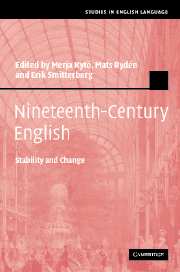Book contents
- Frontmatter
- Contents
- List of plates
- List of figures
- List of tables
- List of contributors
- Acknowledgements
- Introduction: Exploring nineteenth-century English – past and present perspectives
- 1 Modifiers describing women and men in nineteenth-century English
- 2 Words in English Record Office documents of the early 1800s
- 3 The subjunctive in adverbial clauses in nineteenth-century English
- 4 The passive in nineteenth-century scientific writing
- 5 Relativizers in nineteenth-century English
- 6 Anaphoric reference in the nineteenth century: that/those + of constructions
- 7 Adjective comparison in nineteenth-century English
- 8 Nonfinite complement clauses in the nineteenth century: the case of remember
- 9 The in -ing construction in British English, 1800–2000
- 10 Partitive constructions in nineteenth-century English
- Appendix
- References
- Name index
- Subject index
3 - The subjunctive in adverbial clauses in nineteenth-century English
Published online by Cambridge University Press: 22 September 2009
- Frontmatter
- Contents
- List of plates
- List of figures
- List of tables
- List of contributors
- Acknowledgements
- Introduction: Exploring nineteenth-century English – past and present perspectives
- 1 Modifiers describing women and men in nineteenth-century English
- 2 Words in English Record Office documents of the early 1800s
- 3 The subjunctive in adverbial clauses in nineteenth-century English
- 4 The passive in nineteenth-century scientific writing
- 5 Relativizers in nineteenth-century English
- 6 Anaphoric reference in the nineteenth century: that/those + of constructions
- 7 Adjective comparison in nineteenth-century English
- 8 Nonfinite complement clauses in the nineteenth century: the case of remember
- 9 The in -ing construction in British English, 1800–2000
- 10 Partitive constructions in nineteenth-century English
- Appendix
- References
- Name index
- Subject index
Summary
Introduction
In Present-day English the subjunctive in adverbial clauses is rare. It is limited by and large to the verb be (especially were). This was not the case in Early Modern English: in this period the subjunctive occurred quite frequently, in a variety of adverbial clauses. The path of development between these two periods has received little attention in previous research. To remedy this, our study maps the use and development of the subjunctive in adverbial clauses in an intervening period, i.e. nineteenth-century English, exemplified in (1).
(1) If the gold be comparatively abundant, a part will soon settle, i.e. in twenty-four or forty-eight hours; […]
(Science, Michael Faraday, 1850–70, p. 413)In our primarily quantitative investigation, we will focus on variation across time and across genre, but we will also briefly discuss the gender variable in the Letters genre. In addition, we will consider patterns of usage in different adverbial clauses headed by a variety of conjunctions, and patterns with different verbs. We define the subjunctive in morpho-syntactic terms, that is to say, this chapter is concerned with verb forms which have a distinct subjunctive marking in a specific syntactic environment. This definition enables a variationist approach to the subjunctive, and, consequently, we will examine the use of the subjunctive in relation to that of both modal auxiliary constructions and the indicative. Our data derives from CONCE, a stratified multi-genre corpus of nineteenth-century English.
- Type
- Chapter
- Information
- Nineteenth-Century EnglishStability and Change, pp. 89 - 109Publisher: Cambridge University PressPrint publication year: 2006
- 3
- Cited by

